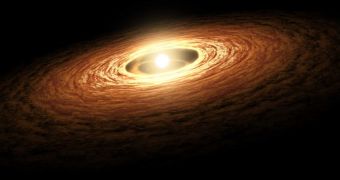While studying a region of space located about 700 light-years from Earth, in the southern constellation Centaurus, astronomers discovered that the young star V1052 displays a unique feature around it – a very clearly-countered carbon monoxide ring.
While seeing such a ring is not unusual in itself, researchers found it puzzling that the structure have very sharp and clear edges. Usually, the chemical is spread out throughout new stars' protoplanetary rings, which are a collection of gas and dust particles that eventually give birth to planets.
But V1052 is surrounded by a type of CO ring that researchers have never seen before. Discovering the structure was only made possible by the use of the Very Large Telescope (VLT), an optical interferometry telescope that the European Southern Observatory (ESO) is operating in Chile.
The leader of the international astronomical collaboration that conducted the study, University of Michigan (U-M) professor emeritus Charles Cowley, says that the CO ring is shaped like a rope. Usually, the gas looks more like a dinner plate.
“It's exciting because this is the most constrained ring we've ever seen, and it requires an explanation. At present time, we just don't understand what makes it a rope rather than a dish,” the expert says.
But some of the most interesting questions regarding the structure is why it doesn't get ripped apart by the extremely turbulent motions in the protoplanetary disk. Could it be that this highly-organized structure is temporary? If so, does it occur around all new stars?
Another mystery that Cowley and his team seem determined to resolve is finding out the forces that keep this CO ring undisturbed. One possible explanation may be the presence of strong magnetic fields.
Another idea the researchers advanced was that forming protoplanets keep the ring perfectly shaped, similarly to how moons orbiting the gas giant Saturn keep some of its rings perfectly organized.
“What makes this star so special is its very strong magnetic field and the fact that it rotates extremely slow compared to other stars of the same type,” explains Leibniz Institute for Astrophysics expert Swetlana Hubrig. The LIA is located in Potsdam, Germany.
Details of the study appear in a paper entitled “The narrow, inner CO ring around the magnetic Herbig Ae star HD 101412,” published in the latest online issue of the esteemed journal Astronomy and Astrophysics. The work was led by experts from U-M, LIA, ESO and the Istituto Nazionale die Astrofisica, in Italy.

 14 DAY TRIAL //
14 DAY TRIAL //